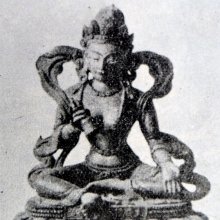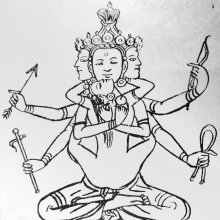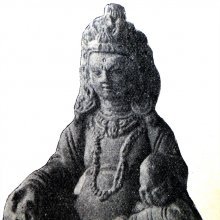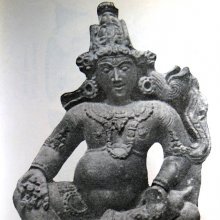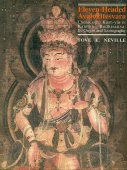Emerald: 2 definitions
Introduction:
Emerald means something in Hinduism, Sanskrit, the history of ancient India. If you want to know the exact meaning, history, etymology or English translation of this term then check out the descriptions on this page. Add your comment or reference to a book if you want to contribute to this summary article.
Images (photo gallery)
In Hinduism
Ayurveda (science of life)
Rasashastra (Alchemy and Herbo-Mineral preparations)
Source: History of Science in South Asia: Making Gems in Indian Alchemical LiteratureEmeralds (in Sanskrit: Marakata) were commonly manufactured in ancient India, using alchemical formulas, as explained according to the Vādakhaṇḍa section of the Rasaratnākara (lit. “jewel mine of mercury”): a 13th century alchemical work in Sanskrit written by Nityanātha.—Verses 1-40 of chapter 19 continues with a series of formulations for creating gems, such as Emeralds (marakata). These formulations stand on their own and do not seem to be integrated into a larger alchemical programme of making mercurial elixirs.

Āyurveda (आयुर्वेद, ayurveda) is a branch of Indian science dealing with medicine, herbalism, taxology, anatomy, surgery, alchemy and related topics. Traditional practice of Āyurveda in ancient India dates back to at least the first millenium BC. Literature is commonly written in Sanskrit using various poetic metres.
India history and geography
Source: Singhi Jain Series: Ratnaprabha-suri’s Kuvalayamala-katha (history)Emerald was used as a material for Foot-stools which commonly decorated the rooms attached to the Vimānas (temple complex) of ancient India, as vividly depicted in the Kathās (narrative poems) such as Uddyotanasūri in his 8th-century Kuvalayamālā (a Prakrit Campū, similar to Kāvya poetry).—Page 92.24-31: [...] Such was the external appearance of Vimāna but in its middle portion or inside there were living apartments with rooms or retiring chambers beautified all-round with pearl-festoons furnished with a bed spread of chalcedony and blue stone, foot-stool of emerald, placed on a floor of precious stones and furnished above with a devāṅga cloth and upper canopy like devadūṣya cloth.

The history of India traces the identification of countries, villages, towns and other regions of India, as well as mythology, zoology, royal dynasties, rulers, tribes, local festivities and traditions and regional languages. Ancient India enjoyed religious freedom and encourages the path of Dharma, a concept common to Buddhism, Hinduism, and Jainism.
See also (Relevant definitions)
Starts with: Emerald creeper, Emerald fern.
Full-text (+185): Marakata, Rajanila, Harinmani, Ashmagarbha, Lomasara, Panna, Rauhineya, Sauparṇa, Masara, Indranilaka, Haritashman, Pacu, Jamburdi, Ashmayoni, Garudapaca, Marakatamaya, Garudankita, Garuda, Shanipriya, Marakatashila.
Relevant text
Search found 87 books and stories containing Emerald; (plurals include: Emeralds). You can also click to the full overview containing English textual excerpts. Below are direct links for the most relevant articles:
Rasa Jala Nidhi, vol 3: Metals, Gems and other substances (by Bhudeb Mookerjee)
Part 2 - Test of Genuine Emerald < [Chapter XIV - Gems (2): Marakata (emerald)]
Part 1 - Characteristics of Emerald (marakata) < [Chapter XIV - Gems (2): Marakata (emerald)]
Part 3 - Uparatna (3): Puttika (peridote) < [Chapter XXVII - Uparatna (minor gems)]
The Garuda Purana (by Manmatha Nath Dutt)
Chapter LXXI - Tests of Emerald < [Agastya Samhita]
Chapter LXVIII - Description of the origin of gems in the treatise on Ratna Pariksa (test of gems) < [Agastya Samhita]
Cosmetics, Costumes and Ornaments in Ancient India (by Remadevi. O.)
2.6. Finger Ornaments (a): Aṅgulīyaka < [Chapter 3 - Ornaments]
1.2. Materials (d): Marakata (Emerald) < [Chapter 3 - Ornaments]
2.5. Hand Ornaments (a): Keyūra < [Chapter 3 - Ornaments]
Ramayana of Valmiki (by Hari Prasad Shastri)
Chapter 7 - Description of the Aerial Chariot Pushpaka < [Book 5 - Sundara-kanda]
Chapter 10 - Hanuman sees Ravana surrounded by his Wives < [Book 5 - Sundara-kanda]
Chapter 124 - Bibishana places the Chariot Pushpaka at Rama’s disposal < [Book 6 - Yuddha-kanda]
Brihat Samhita (by N. Chidambaram Iyer)
Chapter 83 - On Emeralds (marakata-lakṣaṇa)
Chapter 80 - On Gems (ratna-parīkṣā)
Harshacharita (socio-cultural Study) (by Mrs. Nandita Sarmah)
14.2. Ornaments (Bhūṣā) < [Chapter 6 - Other Socio-Cultural Aspects]
2. Description of Hermitage Life < [Chapter 6 - Other Socio-Cultural Aspects]
Related products
